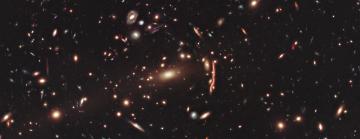Galaxy clusters yield new evidence for standard model of cosmology
A new study probing the structure and evolution of galaxy clusters shows good agreement with the predictions of standard cosmological models.
Cosmologists have found new evidence for the standard model of cosmology – this time, using data on the structure of galaxy clusters.
In a recent study, a team led by physicists at the Department of Energy's SLAC National Accelerator Laboratory and Stanford University made detailed measurements of the X-ray emission from galaxy clusters, which revealed the distribution of matter within them. In turn, the data helped the scientists test the prevailing theory of the structure and evolution of the universe, known as Lambda-CDM.
Getting there wasn’t an easy task, however.
Here's the trouble: Inferring the mass distributions of galaxy clusters from their X-ray emission is most reliable when the energy in the gas within clusters is balanced by the pull of gravity, which holds the whole system together. Measurements of the mass distributions in real clusters therefore focus on those that have settled down to a "relaxed" state. When comparing to theoretical predictions, it is therefore essential to take this selection of relaxed clusters into account.
Keeping this in mind, Stanford physics graduate student Elise Darragh-Ford and her colleagues examined computer-simulated clusters produced by the The Three Hundred Project. First, they computed what the X-ray emission for each simulated cluster should look like. Then, they applied the same observational criteria used to identify relaxed galaxy clusters from real data to the simulated images to winnow the set down.
The researchers next measured the relationships between three properties – the cluster mass, how centrally concentrated this mass is, and the redshift of the clusters, which reflects how old the universe was when the light we observe was emitted – for both the simulated Three Hundred Project clusters and 44 real clusters observed with NASA’s Chandra X-ray Observatory.
The team found consistent results from both data sets: overall, clusters have become more centrally concentrated over time, while at any given time, less massive clusters are more centrally concentrated than more massive ones. "The measured relationships agree extremely well between observation and theory, providing strong support for the Lambda-CDM paradigm," said Darragh-Ford.
In the future, the scientists hope to be able to expand the size of both the observed and simulated galaxy cluster data sets in their analysis. SLAC-supported projects coming online in the next few years, including the Rubin Observatory's Legacy Survey of Space and Time and the fourth-generation cosmic microwave background experiment (CMB-S4), will help identify a much larger number of galaxy clusters, while planned space missions, such as the European Space Agency's ATHENA satellite, can follow up with X-ray measurements. SLAC cosmologists are also working to expand the size and accuracy of computer simulations of the cosmos, making it possible to study galaxy clusters in greater detail and place stringent limits on alternative cosmological scenarios.
The research was supported by the National Aeronautics and Space Administration and the DOE Office of Science.
Citation: Elise Darragh-Ford, Monthly Notices of the Royal Astronomical Society, 23 February 2023 (10.1093/mnras/stad585)
Contact
For questions or comments, contact the SLAC Office of Communications at communications@slac.stanford.edu.
About SLAC
SLAC National Accelerator Laboratory explores how the universe works at the biggest, smallest and fastest scales and invents powerful tools used by researchers around the globe. As world leaders in ultrafast science and bold explorers of the physics of the universe, we forge new ground in understanding our origins and building a healthier and more sustainable future. Our discovery and innovation help develop new materials and chemical processes and open unprecedented views of the cosmos and life’s most delicate machinery. Building on more than 60 years of visionary research, we help shape the future by advancing areas such as quantum technology, scientific computing and the development of next-generation accelerators.
SLAC is operated by Stanford University for the U.S. Department of Energy’s Office of Science. The Office of Science is the single largest supporter of basic research in the physical sciences in the United States and is working to address some of the most pressing challenges of our time.






